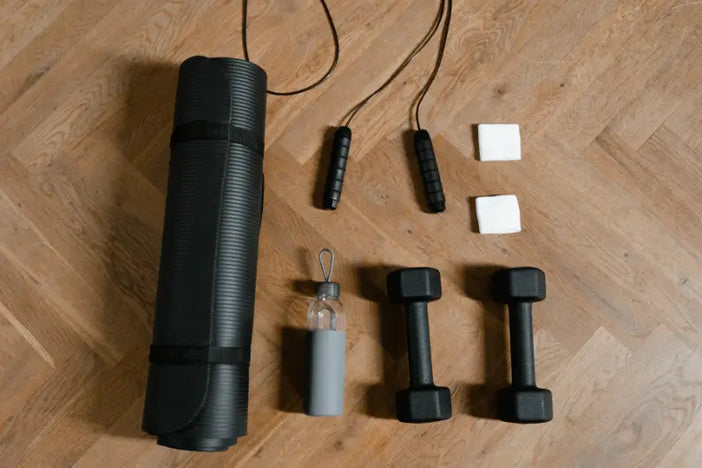TOP 4 exercises you can do right now to improve your heart health

When you are considering the benefits of exercising, the words "weight loss" and "becoming ripped" often rush to mind first. However, there is one advantage that is even more important than just staying in shape. A regular exercise routine can boost heart health and help you maintain over time a healthy heart. Your heart is the most vital part of your body, that is why you should give it some special care, right?
Peer-reviewed studies showed that a sedentary lifestyle can raise the risk of colon cancer, high blood pressure, osteoporosis, lipid disorders, depression, and anxiety, as well as double the risk of cardiovascular disease, diabetes, and obesity. February is National Heart Month, a wonderful opportunity to focus our attention on ways to promote and maintain heart health.
Let's have a look at some of the best exercises for keeping your heart healthy, that will affect and reduce your risk of heart disease and stroke. Physical activity and exercise can help you not only prevent heart attacks and cardiac infractions but also improve and manage heart diseases that have already developed.
Strengthening your muscles allows them to become more effective and capable to pump blood throughout your body. The more you train your heart, the stronger it grows, comparable to your biceps. The best types of workouts for good heart health are listed in this article.
What types of exercises improve heart health and what are the benefits of it?
Regular physical activity and exercise provide a number of heart-healthy advantages, including:
Strengthens the heart muscle or myocardium.
Lung function is improved.
Lowered blood pressure.
Reduces high cholesterol levels.
Reduces high blood sugar levels.
Reduces high triglyceride levels.
C-reactive protein, an inflammatory protein that is high in chronic situations, is reduced.
This reduces the chances of developing heart disease or having a heart attack.
Aerobic exercises like jumping rope, weight training, and stretching should all be included in your workout program to enhance your heart health and minimize your risk factors for heart problems. Before any vigorous-intensity aerobic exercise ask for professional medical advice. Your healthcare provider will give you the best advice on which exercise precautions you personally should take to keep your heart healthy.

Aerobic exercise
"Needs oxygen" is what "aerobic" implies. During aerobic activity, a consistent supply of oxygen is used, while fat and carbohydrates are burned for energy. It raises your heart rate and keeps it there for extended periods of time. That is why it is frequently referred to as "cardio." Cardio is an exercise that's good for the heart because it keeps your blood vessels and heart-healthy.
Aerobic exercise improves circulation. It can help you improve your overall stamina and musculoskeletal health and heart health. The most essential organ in your body, the heart, needs regular exercise to be healthy. Regular aerobic exercise can also reduce your risk of developing a variety of serious illnesses, including diabetes, high blood pressure, heart disease, and stroke. It is an important factor for weight loss and weight control.
Stretching
Stretching is a type of exercise that improves muscular flexibility and the capacity to move your joints through their complete range of motion. To reduce the risk of injury during physical activity and exercise, proper flexibility and joint mobility are required. Flexibility exercises are not hard but they take time to practice. Stretching helps to reduce parameters that increase the risk of heart disease.

Resistance Training
Resistance work, often known as strength training, is a type of exercise designed to develop strength. Weight lifting and other kinds of resistance training and strength training are examples of anaerobic exercise. The anaerobic exercise entails a brief burst of high-intensity activity that relies only on the burning carbohydrates for energy. Regular physical activity in form of strength training, stretching or cardio will reduce heart disease risk. It does not need the use of oxygen. Free weights, resistance bands, or your body weight can all be used to provide resistance, as can motion like:
- Push-ups;
- Pull-ups;
- Dips or Squats;
- Lunges;
- Step-ups.
4 best exercises for a healthy heart using your own body weight and prevent heart disease
1. Walking
For those with diabetes, walking is one of the most popular and generally advised types of physical activity. It's simple to do, relaxing, and can be done almost anywhere. Most importantly, it is quite helpful in regulating blood sugar levels. Walking as an exercise routine will activate major muscle groups and keep your heart healthy.
How to start this exercise for beginners
Individuals who have been inactive should always begin carefully and progressively increase their exercise intensity, duration, and frequency over time. Your healthcare physician may offer you special safety measures to follow if you feel short of breath fast, have a heart issue, or have high blood pressure.
Walking at a moderate speed of 3 miles per hour is a safe and effective approach to add moderate-intensity physical exercise to your day for most people without serious heart and blood vessels, lung, or joint problems.
Begin gently and comfortably. If that's all you have time for on the first day, 5 or 10 minutes of brisk walking is completely appropriate. The most essential thing is to avoid becoming hurt or uncomfortable since this might put a stop to a walking routine before it even begins.
Every week, add 5 or 10 minutes. Aim for 45 minutes to an hour of a brisk walk, five to seven days a week as one's skills grow. This is the best amount of time to maintain blood glucose levels.

2. Rowing
Rowing on a regular basis might help you maintain a healthy weight and body fat percentage. Things that are beneficial for diabetes management. Rowing can also assist to improve insulin sensitivity and restore normal glucose metabolism.
It works on all of your major muscle groups. The starting position is considering that muscles tense and relaxes with the movement of rowing. As they consume sugar for energy as you row. The body uses glucose resources in your blood to satisfy the energy requirement, it burns more calories and it's lowering your blood glucose level in the process.
Adults should engage in muscle-strengthening moderate-intensity exercises two or more times per week, according to the Department of Health and Human Services (DHHS) Physical Activity Guidelines. How much your blood glucose is decreased is determined by the length and intensity of your workouts. Let your muscles recover for a day between sessions of rowing and make sure to start the workout with slow and then gradually increase to moderate intensity.
How to start this exercise for beginners
Before beginning an exercise regimen, the American Diabetes Association recommends that anybody with diabetes get a full medical examination. Pre, during, and post-aerobic activity blood sugar checks can help you prevent setbacks and achieve your goals.

3. Tai chi
Studies have shown that moderate exercise can prevent diabetes in 60% of instances. As a result, this type of sport is useful in preventing and improving diabetes control since it is a moderate exercise. Diabetes management is affected by stress. Because practices promote mental relaxation and decrease stress, it's no surprise that they can help with diabetes management.
The associated consequences of diabetes, such as heart disease, artery damage, bad cholesterol, stroke, and heart failure are the most serious issues. It combines slow, flowing motions with mental images and deep breathing to improve strength, balance, and flexibility.
It has been demonstrated in scientific research to improve cardio-respiratory fitness, muscular strength, balanced heart rate, peripheral circulation, stress reduction, and anxiety reduction.
How to start this exercise for beginners
You can subscribe to online lessons or find a local studio that teaches Tai chi. Each studio has its own approach but it always sums up to a gentle and great experience. A major step is starting and trying to understand is this something you will enjoy in longer periods despite your diagnosis or treatment.

4. Swimming
Swimming is beneficial for people with diabetes and it can reduce your risk of developing complications. Swimming laps can help regulate blood sugar levels in Type 2 and gestational diabetes, it can help with multiple chronic conditions and lower the risk of cardiovascular disease. It improves insulin sensitivity, which can help you lose weight or maintain a healthy heart.
Swimming can lower LDL levels and raise HDL or "good" cholesterol. The chance of dying from heart disease decreases by 3.5 percent for every 1% rise in HDL cholesterol. Aerobic activity, such as swimming, has also been shown in studies to maintain the layer of cells lining your arteries flexible and in excellent form.
How to start this exercise for beginners
You'll want to carry more than a towel and goggles to your swim workouts if you have diabetes. To prepare:
Have a modest snack that contains protein, fat, and complex carbohydrates.
Wearing lightweight water shoes in the pool and shower sandals in the locker room can help protect your feet by reducing the risk of bruising or cutting them, as well as the spread of the athlete's foot. Read more about proper foot care here.
In a tiny plastic bag, keep a glucose meter and food by the pool.
Make the lifeguard aware of your diabetes. Before you enter the pool, check your blood glucose levels. Your blood sugar should be higher than 100 mg/dl or at a level determined by your doctor.



